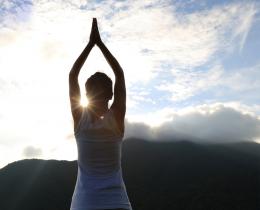In this excerpt from Yoga With Weights for Dummies, author Sherri Baptiste provides tips on how to master posture alignment techniques for yoga with weights. They're great tips for a yoga practice without weights, too.
Posture alignment refers to how your muscles are integrated and bones are aligned to support your body for optimal movement during exercise. The aim of good posture alignment is to establish a solid foundation with your body so you can support your limbs, back, and head while you exercise. You want your body to be safe, secure, and able to expand more fully and freely during each exercise.
To avoid injury and to get more out of yoga-with-weights exercises, it pays to practice proper posture alignment. Posture-alignment techniques give you a greater sense of stability and balance not only when you exercise, but also when you stand in lines or sit for long periods of time. The better your posture is, the fewer injuries you’re prone to in exercise and in daily life.
Here are some general guidelines for yoga-with-weights exercises that deal with posture alignment:
Engage your core muscles. Your core muscles are the muscles in your trunk and torso that are responsible for supporting your spine. When you engage these muscles, it feels as though you’re wearing a tight-fitting spandex suit on your body because you have a “hugged-in” feeling. You feel empowered when you move from your core muscles into all the exercises.
Draw your belly in and up and your tailbone down. As your tailbone drops toward the floor, your legs strengthen, and you press your leg muscles up against the bone where they can support your body. You should feel the muscles hugging the bones as the bones begin lengthening.
Press into all four corners of your feet. You root downward through the soles of your feet to create depth and stability while you exercise. You should feel equal weight on the front and back of each foot as well as on the sides. Feel the corners of your heel and the ball or pad on the front of your foot—especially the area below your big toe and baby toes—pressing downward. You should also feel the arches of your feet gently lifting up as if energy from the front of your shins is pulling your arches up. The feeling continues through your knees as your thigh muscles gently lift your knees upward.
Stabilize and center your head between your shoulders. Gaze forward with your chin naturally down, not lifted or tilted. Draw your shoulders away from your ears and your shoulder blades down your back. Make sure your chest is comfortable, spread your collarbones wide, and give a slight lift to your breast bone or sternum, lifting naturally. Stand with your hips aligned over your knees and with your knees over your heels.
Spread your fingers wide. When your hands are on the floor for exercises and you’re supporting your body with your hands, spread your fingers wide so that each finger is active and pressing firmly on the floor to help support your body.
Place your shoulders over your wrists and hands and your hips over your knees. This is for exercises that require you to be on all fours. When you’re in this position, make sure you distribute your body weight evenly over your wrists, hands, and knees and that you fully engage the core muscles of your trunk. When you’re lifting a hand weight or an ankle weight, always make sure not to hurry. Lift the weight in a slow, controlled fashion. When you go slow, you make your body more stable and capable of supporting the weight, you isolate the muscle you want to work more effectively, and you don’t cheat by relying on your momentum to lift the weight.
No matter what yoga-with-weights exercise you’re doing, your entire body should be involved. In addition to keeping your core body engaged, before you do an exercise, direct your thoughts to the specific area that’s most actively involved in that particular exercise. For example, if you’re doing bicep curls, focus on your biceps. By directing your mind to the specific body action, you enhance your body-mind connection and create a more empowered workout. This technique is also excellent for mental conditioning.



